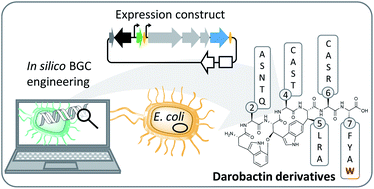Improved broad-spectrum antibiotics against Gram-negative pathogens via darobactin biosynthetic pathway engineering†
Abstract
The development of new antibiotics is imperative to fight increasing mortality rates connected to infections caused by multidrug-resistant (MDR) bacteria. In this context, Gram-negative pathogens listed in the WHO priority list are particularly problematic. Darobactin is a ribosomally produced and post-translationally modified bicyclic heptapeptide antibiotic selectively killing Gram-negative bacteria by targeting the outer membrane protein BamA. The native darobactin A producer Photorhabdus khanii HGB1456 shows very limited production under laboratory cultivation conditions. Herein, we present the design and heterologous expression of a synthetically engineered darobactin biosynthetic gene cluster (BGC) in Escherichia coli to reach an average darobactin A production titre of 13.4 mg L−1. Rational design of darA variants, encoding the darobactin precursor peptide with altered core sequences, resulted in the production of 13 new ‘non-natural’ darobactin derivatives and 4 previously hypothetical natural darobactins. One of the non-natural compounds, darobactin 9, was more potent than darobactin A, and showed significantly improved activity especially against Pseudomonas aeruginosa (0.125 μg mL−1) and Acinetobacter baumannii (1–2 μg mL−1). Importantly, it also displayed superior activity against MDR clinical isolates of E. coli (1–2 μg mL−1) and Klebsiella pneumoniae (1–4 μg mL−1). Independent deletions of genes from the darobactin BGC showed that only darA and darE, encoding a radical forming S-adenosyl-L-methionine-dependent enzyme, are required for darobactin formation. Co-expression of two additional genes associated with the BGCs in hypothetical producer strains identified a proteolytic detoxification mechanism as a potential self-resistance strategy in native producers. Taken together, we describe a versatile heterologous darobactin platform allowing the production of unprecedented active derivatives in good yields, and we provide first experimental evidence for darobactin biosynthesis processes.



 Please wait while we load your content...
Please wait while we load your content...